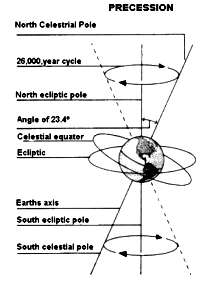precession

Precession is a slow, periodic conical motion of the rotation axis of a spinning body, most familiar in the wobbling of a toy top or gyroscope. Earth's axis precesses, once around every 25,800 years (a period known as a Platonic year), as a result of it not being perpendicular to the ecliptic (the plane of Earth's orbit around the Sun). Being tipped over at about 23.5°, it is affected by gravitational perturbations from other bodies in the Solar System, including the Sun, Moon, and planets. These bodies pull harder on the part of Earth's equatorial bulge nearest them than on the part farthest away, resulting in a torque that is the underlying cause of precession.
The component of precession caused by the Sun and Moon is called lunisolar precession; that caused by the action of the planets is called planetary precession. The sum of lunisolar and planetary precession, known as general precession, results in a westward movement of the equinoxes (the nodes of the ecliptic) known as the precession of the equinoxes. This movement amounts to an average of about 50.3" per year – the so-called precession constant. Precession means that a number of different stars in the circumpolar regions of the celestial sphere serve as pole stars on a cyclical basis.
Geodetic precession is a small, relativistic, direct motion of the equinox along the ecliptic, amounting to 1.915 arcsecondsper century.


